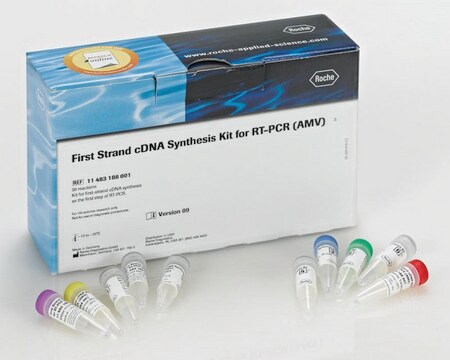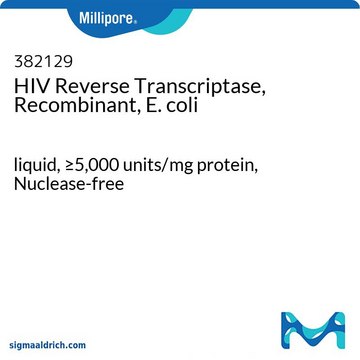M1302
M-MLV Reverse Transcriptase
Moloney Murine Leukemia Virus enzyme & buffer for cDNA synthesis
Sinónimos:
Moloney Murine Leukemia Virus Reverse Transcriptase
About This Item
Productos recomendados
biological source
Porcine intestinal mucosa
Quality Level
recombinant
expressed in E. coli
form
liquid
usage
sufficient for 200 reactions
sufficient for 250 reactions
feature
dNTPs included: no
hotstart: no
concentration
200 units/μL
technique(s)
RT-PCR: suitable
color
colorless
input
purified RNA
shipped in
wet ice
storage temp.
−20°C
General description
Application
- for the preparation of cDNA libraries or for first strand cDNA synthesis
- for use in a 2-step RT-PCR assay
- in quantitative realtime-polymerase chain reaction (RT-qPCR)
- in reverse transcription
Features and Benefits
- Thermostable reverse transcriptase active at 37 °C.
- Can be used to generate first strand cDNA of up to 7 kb.
Packaging
Unit Definition
Preparation Note
Legal Information
Related product
inhibitor
signalword
Danger
hcodes
pcodes
Hazard Classifications
Resp. Sens. 1
Storage Class
12 - Non Combustible Liquids
wgk_germany
WGK 3
flash_point_f
Not applicable
flash_point_c
Not applicable
ppe
Eyeshields, Gloves, multi-purpose combination respirator cartridge (US)
Certificados de análisis (COA)
Busque Certificados de análisis (COA) introduciendo el número de lote del producto. Los números de lote se encuentran en la etiqueta del producto después de las palabras «Lot» o «Batch»
¿Ya tiene este producto?
Encuentre la documentación para los productos que ha comprado recientemente en la Biblioteca de documentos.
Los clientes también vieron
Artículos
The introduction of small interfering RNAs (siRNAs) into cultured cells provides a fast and efficient means of knocking down gene expression and has allowed siRNAs to quickly become a ubiquitous tool in molecular biology.
Introduction of small interfering RNAs (siRNAs) into cultured cells provides a fast and efficient means of knocking down gene expression and has allowed siRNAs to quickly become a ubiquitous tool in molecular biology.
Contenido relacionado
RT-qPCR, or quantitative reverse transcription PCR, combines the effects of reverse transcription and quantitative PCR or real-time PCR to amplify and detect specific targets. RT-qPCR has a variety of applications including quantifying gene expression levels, validating RNA interference (RNAi), and detecting pathogens such as viruses.
Nuestro equipo de científicos tiene experiencia en todas las áreas de investigación: Ciencias de la vida, Ciencia de los materiales, Síntesis química, Cromatografía, Analítica y muchas otras.
Póngase en contacto con el Servicio técnico










